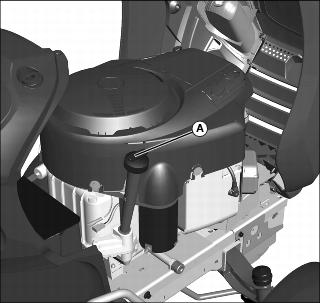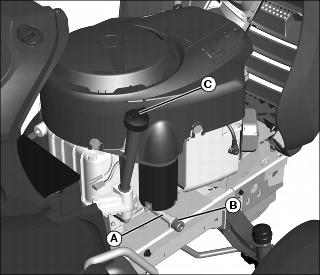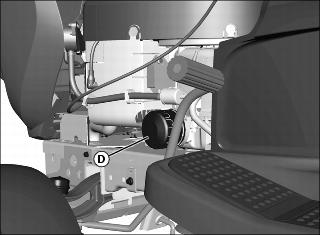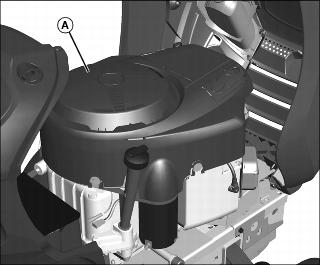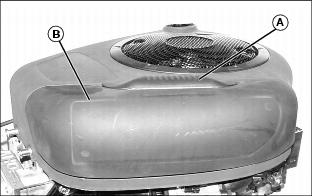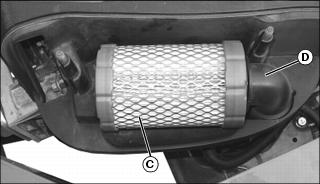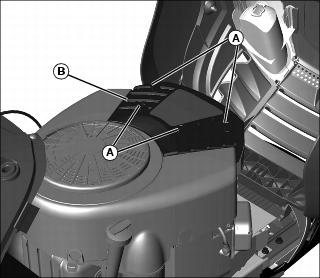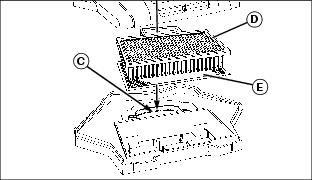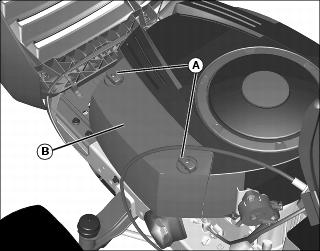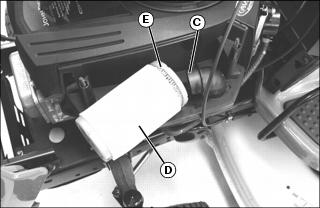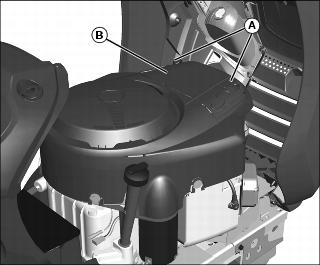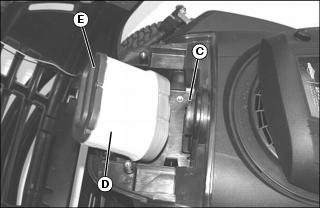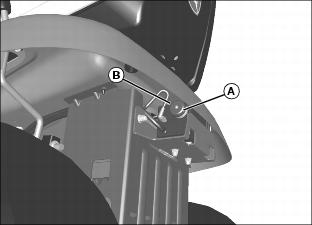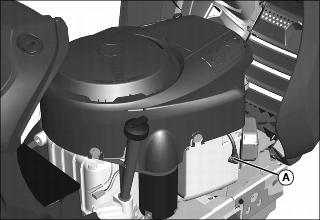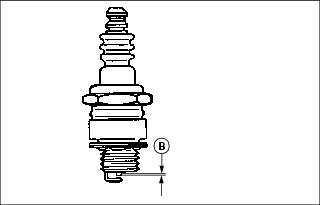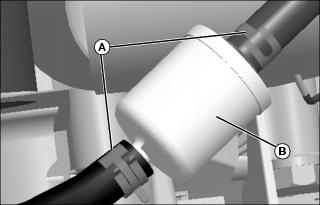
Service Engine
Engine Warranty Maintenance Statement
Maintenance, repair, or replacement of the emission control devices and systems on this engine, which are being done at the customer’s expense, may be performed by any non-road engine repair establishment or individual. Warranty repairs must be performed by an authorized John Deere dealer.
Avoid Fumes
Engine Oil
Use oil viscosity based on the expected air temperature range during the period between oil changes.
The following John Deere oils are preferred:
Other oils may be used if above John Deere oils are not available, provided they meet the following specification:
• API Service Classification SJ or higher
Checking Engine Oil Level
NOTE: Check oil twice a day if you run engine over 4 hours in a day.
Make sure engine is cold when checking engine oil level.
1. Park machine safely. (See Parking Safely in the SAFETY section.)
3. Clean area around dipstick to prevent debris from falling into crankcase.
Picture Note: Twin cylinder engine shown.
4. Remove dipstick (A). Wipe with clean cloth.
5. Install and tighten dipstick.
7. Check oil level on dipstick. Oil must be between ADD and FULL marks.
8. If oil level is low, add oil to bring oil level no higher than FULL mark on dipstick. Do not overfill.
9. Install and tighten dipstick. Lower hood.
Changing Engine Oil and Filter
IMPORTANT: Avoid damage! Change the oil more often if the vehicle is used in extreme conditions: |
2. Park machine safely. (See Parking Safely in the SAFETY section.)
Picture Note: Twin cylinder engine shown.
4. Put drain pan under drain valve (A).
5. Rotate and remove drain cap (B) and drain oil into oil drain pan. Allow oil to drain completely.
Picture Note: Twin cylinder engine shown.
7. Replace oil filter (D), if equipped.
a. Wipe dirt from around oil filter.
b. Place a drain pan or funnel under filter tray.
c. Remove old filter and filter gasket and dispose of properly. Wipe up any spilled oil.
d. Put a light coat of fresh, clean oil on the new filter gasket.
e. Install replacement oil filter by turning oil filter to the right (clockwise) until the rubber gasket contacts filter base. Tighten filter an additional one-half turn.
IMPORTANT: Avoid damage! Do not overfill. Overfilling can cause smoking, hard starting, fouling of spark plug, and oil saturation of air filter. |
9. Add oil no higher than FULL mark on dipstick. Use approximately the amount of oil listed in the Specifications section. Do not overfill.
11. Start and run engine at idle to check for leaks. Stop engine. Fix any leaks before operating.
12. Check oil level. Add oil if necessary.
Cleaning Air Intake Screen and Engine Fins
• Clear work area of bystanders. • Wear eye protection when using compressed air for cleaning purposes. |
1. Park machine safely. (See Parking Safely in the SAFETY section.)
Picture Note: Twin cylinder engine shown.
3. Clean air intake screen (A), cooling fins and external surfaces with rag, brush, vacuum or compressed air.
Checking and Cleaning Air Cleaner Elements (D100 and D110)
1. Park machine safely. (See Parking Safely in the SAFETY section.)
4. Clean dirt and debris from the air cleaner cover.
5. Lift latch (A) to unlock cover (B). Lift cover forward and remove.
6. Inspect the paper filter element (C) without removing it. If the paper filter element is damaged or dirty, replace with new filter:
• Clean air cleaner base very carefully, preventing any dirt from falling into carburetor.
• Carefully pull the paper element from the air cleaner elbow (D).
• Install new paper filter element back onto air cleaner elbow.
7. Install air cleaner cover and push latch down to lock.
Checking and Cleaning Air Cleaner Elements (D130 and D140)
1. Park machine safely. (See Parking Safely in the SAFETY section.)
4. Clean dirt and debris from the air cleaner cover.
5. Loosen four knobs (A) and remove cover (B).
IMPORTANT: Avoid damage! To prevent engine damage, do not allow any foreign objects to fall into the carburetor air intake. |
6. Do not drop anything into the carburetor air intake (C). If anything falls into the carburetor air intake it must be removed.
7. Lift out filter cartridge (D) and inspect it for damage.
8. Inspect the foam precleaner (E) without removing it. If the foam precleaner is dirty:
a. Remove it from the filter carefully.
b. Wash precleaner in a solution of warm water and liquid detergent.
c. Rinse precleaner thoroughly. Squeeze out excess water in a dry cloth until precleaner is completely dry.
9. Clean air cleaner housing carefully. Prevent any dirt from falling into carburetor.
10. Install foam precleaner mesh side up.
11. Install cartridge. Make sure cartridge and seal are properly seated and sealing the carburetor air intake area.
12. Install air cleaner cover and tighten knobs. Do not overtighten.
Checking and Cleaning Air Cleaner Elements (D120)
1. Park machine safely. (See Parking Safely in the SAFETY section.)
4. Clean dirt and debris from the air cleaner cover.
5. Loosen two knobs (A) and remove cover (B).
6. Pull filter assembly from air cleaner base (C). Inspect the foam precleaner (D) without removing it. If the foam precleaner is dirty:
a. Remove it from the paper filter carefully.
b. Wash precleaner in a solution of warm water and liquid detergent. Do not use oil.
c. Rinse precleaner thoroughly. Squeeze out excess water in a dry cloth until precleaner is completely dry.
7. Inspect the paper filter element (E). If the paper filter element is damaged or dirty, replace with new filter.
8. Clean air cleaner base very carefully, preventing any dirt from falling into carburetor.
9. Install foam precleaner on paper filter element.
10. Install new filter assembly back onto air cleaner base.
11. Install air cleaner cover and tighten two knobs.
Checking and Cleaning Air Cleaner Elements (D160 and D170)
1. Park machine safely. (See Parking Safely in the SAFETY section.)
4. Clean dirt and debris from the air cleaner cover.
5. Loosen two knobs (A) and remove cover (B).
6. Pull filter assembly from air cleaner base (C). Inspect the foam precleaner (D) without removing it. If the foam precleaner is dirty:
a. Remove it from the paper filter carefully.
b. Wash precleaner in a solution of warm water and liquid detergent. Do not use oil.
c. Rinse precleaner thoroughly. Squeeze out excess water in a dry cloth until precleaner is completely dry.
7. Inspect the paper filter element (E). If the paper filter element is damaged or dirty, replace with new filter.
8. Clean air cleaner base very carefully, preventing any dirt from falling into carburetor.
9. Install foam precleaner on paper filter element.
10. Install new filter assembly back onto air cleaner base.
11. Install air cleaner cover and tighten two knobs.
Checking and Cleaning Emission Filter (If Equipped)
1. Park machine safely. (See Parking Safely in the SAFETY section.)
2. Inspect filter (A) for dirt and damage, wash or replace if required.
a. Remove cover (B) and remove emission filter (A) from under rear of fender deck.
b. Wash foam filter in a solution of warm water and liquid detergent. Do not use oil.
c. Rinse filter thoroughly. Squeeze out excess water in a dry cloth until filter is completely dry.
If foam filter cannot be cleaned properly or is damaged, replace with a new filter.
d. Install foam air filter and secure with cover.
Checking Spark Plug
1. Park machine safely. (See Parking Safely in the SAFETY section.)
Picture Note: Twin cylinder engine shown.
4. Disconnect spark plug wire(s) (A), one on each side on V-twin engines.
6. Clean spark plug carefully with a wire brush.
• Pitted or damaged electrodes.
8. Replace spark plug as necessary.
9. Check plug gap (B) with a wire feeler gauge. To change gap, move the outer electrode.
• Gap must be 0.76 mm (0.030 in.).
10. Install and tighten spark plugs to 20 N•m (15 lb-ft).
11. Connect spark plug wire(s) and lower hood.
Adjusting Carburetor
NOTE: Carburetor is calibrated by the engine manufacturer and is not adjustable.
If engine is operated at altitudes above 1829 m (6,000 ft), some carburetors may require a special high altitude main jet. See your authorized dealer.
If engine is hard to start or runs rough, check the TROUBLESHOOTING section of this manual.
Possible engine surging will occur at high throttle with transmission in N neutral and mower engagement lever disengaged. This is a normal condition due to the emission control system.
After performing the checks in the troubleshooting section and your engine is still not performing correctly, contact your authorized dealer.
Replacing Fuel Filter
NOTE: Change filter when fuel is low.
1. Park machine safely. (See Parking Safely in the SAFETY section.)
4. Handle fuel safely. (See Handling Fuel Safely in the SAFETY section.)
5. Put a drain pan under fuel filter.
6. Slide hose clamps (A) away from fuel filter (B) using a pliers.
7. Disconnect hoses from filter, and raise fuel lines vertically to avoid fuel drainage.
8. Connect hoses to new filter making sure the filter arrow is pointed in the direction of the fuel flow.

